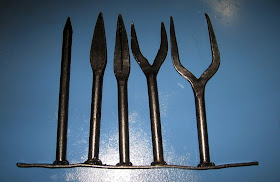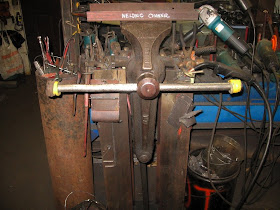

Some question came up and stimulated me to look up something about screw thread. In the process I recalled a couple of long forgotten things and learned a few new ones.
I recalled that someone once told me that the way the standard right-hand wood screw thread helix was designed assumed the screw driver would be held by a right-handed person and drive when turned clockwise. This was based on the knowledge that supination, clockwise rotation of the forearm, was more powerful than pronation, counter clockwise rotation of the forearm, in extension. Lefties were out of luck.
Probably nearly everyone learned “righty tighty, lefty loosey” at some time - clockwise to tighten, counter clockwise to loosen. Apparently this is also known as the right hand grip rule for screw threads.
The action of supination can be produced by the biceps, supinator and brachioradialis muscles. Wikipedia says the later is known as the “beer drinkers muscle.” Now there is a handy bit of knowledge.
Think about the everyday forging practice where we draw a taper. The teaching instructs us to strike a number of blows, two or three, then rotate 90º and strike the same number and repeat until the shape is achieved. The rotation process and equal application of force keeps the deformation of the metal from going too far in one direction.
Today I had a lot of little pieces, screw hooks, to make which required exactly that process. I paid close attention as I worked and noted that, depending on how i picked up the piece, I may start striking while holding the workpiece in full supination. No matter the starting position, after two blows the piece was rotated 90º to strike the next two blows. So there seemed to be theoretically four possible 90º sequences; full supination to neutral and back, neutral to full supination and back, neutral to full pronation and back and full pronation to neutral and back. Most commonly, however, I was working back and forth between about 45º supination and 45º pronation.
I recalled that someone told me to imagine that in this process the tong hand is the “smart hand” and the hammer hand is the “dumb Hand.” The tong hand is mostly responsible for putting the work piece in the correct position for the hammer to strike while the hammer hand is just bringing the hammer up and down in the same arc.
Well, there is more to it than that but as a teaching device it must have been worth something because I still recall it. I also recall Francis Whitaker saying, “If you can’t hold it, you can’t hit it.” This was a plea for choosing tongs which properly fit the work piece and allow it to be manipulated without slippage.
It takes time and practice to develop the motor skills associated with hammer on anvil forging. Repetition is key in learning hand control in this and many other activities.
There is a big difference between watching and doing. I think most casual watches do not appreciate the blacksmiths finesse with both hammer and tong control. They mostly are just aware of the rhythm of the hammer striking, bam, bam, bam and are unaware of the directional nature of the blows, use of top and bottom radius, changes in force associated with changes in the workpiece metal in a falling heat, etc. There is a lot of physics involved and both hands need to be “smart” but skilled is a better word.











































